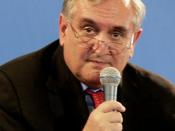With a GDP of 1.7 trillion euros (1.7ÃÂ1012 ; 2005 data), France is the fifth largest economy in the world in USD exchange-rate terms and the seventh largest by purchasing power parity. According to World Bank and IMF figures, it is the third largest in Europe after Germany and the United Kingdom. It has substantial agricultural resources, a large industrial base, and a highly skilled work force. A dynamic services sector accounts for an increasingly large share of economic activity (72% in 1997) and is responsible for nearly all job creation in recent years. GDP growth averaged 2% between 1994 and 1998, with 3% recorded in 2000. Stagnant GDP growth, creeping unemployment, and a trade deficit have characterised a malaise in the French economy since the global economic downturn.
Government economic policy aims to promote investment and domestic growth in a stable fiscal and monetary environment. Creating jobs and reducing the high unemployment rate has been a top priority.
In the 1990s, unemployment fell from 10% to 8-9%, although this has since rebounded to double digits because of the 2001 US recession, but currently, unemployment is hovering just below 10%. France joined 10 other European Union countries in adopting the euro as its currency in January 1999. Since then, monetary policy has been set by the European Central Bank in Frankfurt.
Dirigisme and decline of dirigisme
Following the Second World War, Fifth Republic, France embarked on an ambitious and mostly very successful program of modernization, under state impulse and coordination. This program of dirigisme, mostly implemented by right-wing governments, involved the state control of a minority of the industry, such as transportation, energy and telecommunication infrastructures, as well as various incentives for private corporations to merge or engage in certain projects.
However, dirigisme came to be highly contested after 1981...


